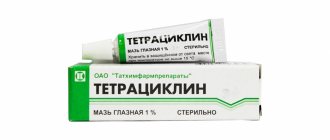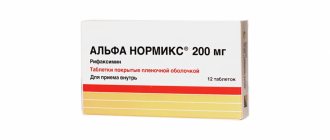Ganaton®
Suction
Itopride hydrochloride is rapidly and almost completely absorbed from the gastrointestinal tract. Relative bioavailability is 60%, which is due to first-pass metabolism through the liver. Food has no effect on bioavailability. The maximum concentration in blood plasma (Cmax 0.28 mcg/ml) is achieved 0.5-0.75 hours after taking 50 mg of itopride hydrochloride.
When itopride hydrochloride was repeatedly taken orally at a dose of 50-200 mg three times a day for 7 days, the pharmacokinetics of the drug and its metabolites were linear, and accumulation was minimal.
Distribution
Itopride hydrochloride is 96% bound to plasma proteins, mainly albumin. Binding to alpha1-acid glycoprotein accounts for less than 15% of total binding.
Itopride is actively distributed into tissue (volume of distribution Vdβ = 6.1 l/kg) and is found in high concentrations in the kidneys, small intestine, liver, adrenal glands and stomach. Penetration into the brain and spinal cord is minimal. Itopride passes into breast milk.
Metabolism
Itopride undergoes active biotransformation in the human liver. 3 metabolites have been identified, only one of which exhibits small activity that has no pharmacological significance (approximately 2-3% of that of itopride). The primary metabolite in humans is N-oxide, which is formed as a result of oxidation of the tertiary amino-N-dimethyl group.
Itopride is metabolized by flavin-dependent monooxygenase (FMO3). The amount and effectiveness of FMO isoenzymes in humans may vary due to genetic polymorphisms, which in rare cases lead to the development of an autosomal recessive condition known as trimethylaminuria (fishy odor syndrome).
Based on pharmacokinetic studies of CYP-mediated reactions in vivo
itopride does not have an inhibitory or inducing effect on the isoenzymes CYP2C19 and CYP2E1. Itopride therapy does not affect CYP or uridine diphosphate glucuronyl transferase activity.
Removal
Itopride hydrochloride and its metabolites are excreted mainly in the urine. Renal excretion of itopride and its N-oxide after a single oral dose of the drug at a therapeutic dose (50 mg) in healthy people was 3.7 and 75.4%, respectively. The half-life of itopride hydrochloride is approximately 6 hours.
Ganaton
Ganaton
(lat.
Ganaton
) - a stimulator of gastrointestinal motility, a new generation prokineticist.
The name comes from English. “gastric natural tone”
- restoring the normal tone of the stomach.
International nonproprietary name of the active substance
of ganatone: itopride.
Ganaton is available in the form of film-coated tablets. One tablet contains 50 mg of active substance
- itopride hydrochloride.
In addition, the tablet core
contains
excipients:
lactose, corn starch, carmellose, anhydrous silicic acid, magnesium stearate and the
tablet shell
: carnauba wax, hypromellose, titanium dioxide and macrogol 6000.
Ganaton is a drug with a combined mechanism of action, which is an antagonist of dopamine D2 receptors and an acetylcholinesterase blocker. Ganaton activates the release of acetylcholine while preventing its degradation. Ganaton penetrates the blood-brain barrier (BBB) in minimal quantities, does not affect the duration of the QT interval and does not interact with drugs metabolized by enzymes of the cytochrome P450 system, including proton pump inhibitors, often used in the treatment of gastroesophageal reflux disease (GERD) and functional dyspepsia. Ganaton has a pronounced antiemetic effect, enhances propulsive motility of the stomach and accelerates its emptying. Ganaton does not affect serum gastrin levels.
The figure schematically shows the pathogenetic factors in the development of gastroesophageal reflux disease and the main drugs used in the treatment of GERD: ganaton and proton pump inhibitors (Maev I.V. et al.).
Indications for use of Ganaton:
- heartburn, nausea, vomiting, anorexia, bloating, feeling of early satiety, discomfort or pain in the upper abdomen
- gastroesophageal reflux disease
- chronic gastritis
Contraindications:
- hypersensitivity to the components of the drug
- bleeding in the stomach or intestines
- perforation of the stomach or intestines
- intestinal obstruction
- age up to 16 years
- pregnancy
- breastfeeding (the active substance of ganaton, itopride, passes into breast milk)
Ganaton take 1 tablet before meals 3 times a day. The daily dose is 3 tablets (150 mg of itopride hydrochloride).
Side effects
Digestive system:
diarrhea, constipation, abdominal pain, increased salivation, nausea, jaundice.
Allergic reactions:
skin hyperemia, itching, rash, anaphylaxis.
Endocrine system:
increased prolactin levels, gynecomastia.
Nervous system:
dizziness, headache, tremor.
Cardiovascular and lymphatic system:
leukopenia, thrombocytopenia.
Laboratory indicators:
increased activity of aspartate aminotransferase, alanine aminotransferase, gammaglutamyl transpeptidase, alkaline phosphatase and bilirubin levels.
Ganaton is quickly and almost completely absorbed from the digestive tract. Its relative bioavailability is 60%, which is associated with first-pass metabolism through the liver. Food has no effect on bioavailability. The maximum plasma concentration of 0.28 mcg/ml is achieved 30 - 45 minutes after taking one Ganaton tablet. When ganaton is taken orally again at a dose of 1 - 4 tablets three times a day for 7 days, the pharmacokinetics of ganaton and its metabolites are linear, and accumulation is minimal.
The active substance of Ganaton, itopride hydrochloride, is 96% bound to plasma proteins, mainly albumin. Binding to alpha1-acid glycoprotein accounts for less than 15% of total binding. Itopride is actively distributed into tissues and is found in high concentrations in the kidneys, small intestine, liver, adrenal glands and stomach. Itopride does not cross the BBB well and therefore its presence in the brain and spinal cord is minimal.
Ganaton undergoes active biotransformation in the human liver. It is metabolized by flavin-dependent monooxygenase, the number and effectiveness of which isoenzymes in humans may vary depending on genetic factors and in rare cases leads to the development of “fish odor syndrome” (trimethylaminuria). In patients with this syndrome, the time it takes itopride to leave the body increases. Itopride does not have an inhibitory or inducing effect on CYP2C19 and CYP2E1 and does not affect CYP or uridine diphosphate glucuronyl transferase activity.
Ganaton and its metabolites are excreted mainly in the urine. The terminal half-life is approximately 6 hours. Renal excretion of itopride and its N-oxide after a single oral dose of ganatone in therapeutic doses in healthy people is 3.7 and 75.4%, respectively.
According to the pharmacological index, Ganaton belongs to the group “Gastrointestinal motility stimulants, including emetics.” According to ATC, it belongs to the group “A03 Drugs for the treatment of functional disorders of the gastrointestinal tract” and has the code “A03FA07 Itopride”.
Ganaton is a prescription drug.
Ganaton Manufacturer: Abbott Japan Co. (Japan).
Other medicinal products with the same active ingredient
. In addition to Ganaton, the following drugs with the active substance itopride (itopride hydrochloride) are registered in Russia - Itomed and Itopra. The drug Primer produced by Mili Healthcare Ltd. is sold in Ukraine. (Great Britain).
Publications for healthcare professionals addressing the treatment of gastrointestinal diseases with Ganaton
- Ivashkin V.T., Sheptulin A.A., Lapina T.L. and others. Recommendations of the Russian Gastroenterological Association for the diagnosis and treatment of functional dyspepsia // RZHGGK. - 2012. - T. 22. - No. 3. - P. 80-92.
- Podleskikh M.N., Tereshchenko S.G., Volchkova E.V. and others. Evaluation of the clinical effectiveness of the prokinetic agent Ganaton (Itopride) as monotherapy and in combination with PPIs for GERD // Farmateka. - 2010. - No. 15. - P. 74-80.
- Belousova L.N., Tkachenko E.I., Uspensky Yu.P. Harmonization of esophageal motility in patients with GERD as a basis for increasing the effectiveness of therapy. Gastroenterology of St. Petersburg. – 2009. – No. 1. - With. 20–24.
- Maev I.V., Samsonov A.A., Odintsova A.N., Belyavtseva E.V., Zadorova M.G. Prospects for the use of a new prokinetic agent with a dual mechanism of action in the treatment of gastroesophageal reflux disease / Farmateka. – 2009. – No. 2. – p. 34–39.
- Minushkin O.N., Loshchinina Yu.N. The effectiveness of the drug Ganaton in the treatment of patients with GERD. “Effective pharmacotherapy in gastroenterology”, No. 3, October 2008, p. 20-24.
- Belenkov Yu.N., Privalova E.V., Yusupova A.O., Kozhevnikova M.V. Coronary heart disease and reflux esophagitis: difficulties of differential diagnosis and treatment of patients // RGGK. – 2011. – No. 3. – T. XXI. – P. 4–12.
- Nurmagomaeva Z.S. Bronchial asthma and gastroesophageal reflux. Diary of the Kazan medical school. No. 2(23), May 2021. pp. 17-20.
On the website in the Literature section there is a subsection “Prokinetics”, containing articles for healthcare professionals on the use of prokinetics in the treatment of diseases of the gastrointestinal tract.
Video for doctors
Still from video: Vologzhanina L.G. The most common mistakes in the treatment of GERD
Video for medical university students
Still from video: Geyvandova N.I. Gastroesophageal reflux disease. Functional diseases of the stomach, biliary tract and intestines
On the website GastroScan.ru in the “Video” section there is a subsection “For doctors”, containing video recordings of reports, lectures, webinars in various areas of gastroenterology for healthcare professionals, as well as a subsection “For students of medical universities”.
Before starting treatment with Ganaton, consultation with a specialist is required !
Back to section
Ganaton, 40 pcs., 50 mg, film-coated tablets
Ganaton - stimulating the tone and motility of the gastrointestinal tract.
Pharmacodynamics
Mechanism of action. Itopride hydrochloride enhances gastric motility by antagonizing D2-dopamine receptors and inhibiting acetylcholinesterase. Itopride activates the release of acetylcholine and inhibits its destruction.
Itopride hydrochloride also provides an antiemetic effect due to interaction with D2 receptors located in the trigger zone. Itopride causes dose-dependent suppression of apomorphine-induced vomiting.
Itopride hydrochloride activates propulsive gastric motility through antagonism of D2 receptors and dose-dependent inhibition of acetylcholinesterase activity.
Itopride hydrochloride has a specific effect on the upper gastrointestinal tract, accelerates gastric transit and improves gastric emptying. Itopride hydrochloride does not affect serum gastrin levels.
Pharmacokinetics
Suction. Itopride hydrochloride is rapidly and almost completely absorbed from the gastrointestinal tract. Its relative bioavailability is 60%, which is associated with first-pass metabolism through the liver. Food has no effect on bioavailability.
After taking 50 mg of itopride hydrochloride orally, Cmax is reached after 0.5–0.75 hours and is 0.28 mcg/ml. When the drug was repeated at a dose of 50–200 mg 3 times a day for 7 days, the pharmacokinetics of the drug and its metabolites were linear, and accumulation was minimal.
Distribution. Binds to plasma proteins (mainly albumin) by 96%. Binding to α1-acid glycoprotein accounts for less than 15% of total binding.
Actively distributed in tissues (Vd is 6.1 l/kg) and is found in high concentrations in the kidneys, small intestine, liver, adrenal glands and stomach. Penetrates the brain and spinal cord in minimal quantities. Passes into breast milk.
Metabolism. Itopride undergoes active biotransformation in the liver. 3 metabolites have been identified, only one of which exhibits small activity that has no pharmacological significance (approximately 2–3% of that of itopride). The primary metabolite is N-oxide, which is formed as a result of oxidation of the quaternary amino-N-dimethyl group.
Itopride is metabolized by flavin-dependent monooxygenase (FMO3). The amount and effectiveness of FMO3 isoenzymes in humans may vary depending on genetic polymorphisms, which in rare cases lead to the development of an autosomal recessive condition known as trimethylaminuria (fishy odor syndrome). In patients with trimethylaminuria, T1/2 of itopride increases.
According to in vivo pharmacokinetic studies, itopride does not have an inhibitory or inducing effect on CYP2C19 and CYP2E1. Itopride therapy does not affect CYP or uridine diphosphate glucuronyl transferase activity.
Excretion. Itopride hydrochloride and its metabolites are excreted mainly in the urine. Renal excretion of itopride and its N-oxide after a single oral dose of the drug in therapeutic doses in healthy people was 3.7 and 75.4%, respectively.
Terminal T1/2 of itopride hydrochloride is about 6 hours.


